The Kingston HyperX Fury RGB SSD Review: Bright Idea, Dimmed Performance
by Billy Tallis on September 24, 2018 8:35 AM ESTMixed Random Performance
Our test of mixed random reads and writes covers mixes varying from pure reads to pure writes at 10% increments. Each mix is tested for up to 1 minute or 32GB of data transferred. The test is conducted with a queue depth of 4, and is limited to a 64GB span of the drive. In between each mix, the drive is given idle time of up to one minute so that the overall duty cycle is 50%.
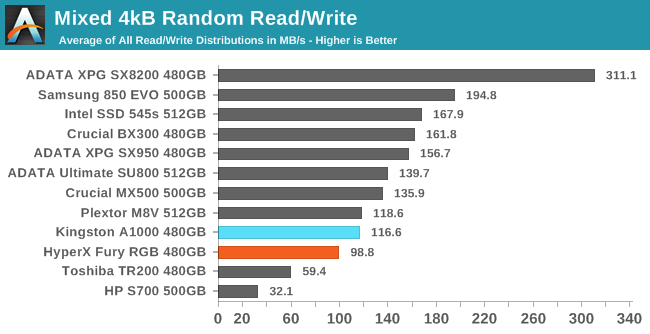
None of the drives in this batch that use Toshiba's BiCS3 3D TLC perform all that well on the mixed random I/O test. The Plextor M8V shows that the HyperX Fury RGB could do a bit better, but at least the Fury RGB is well ahead of the DRAMless Toshiba TR200 on this test.
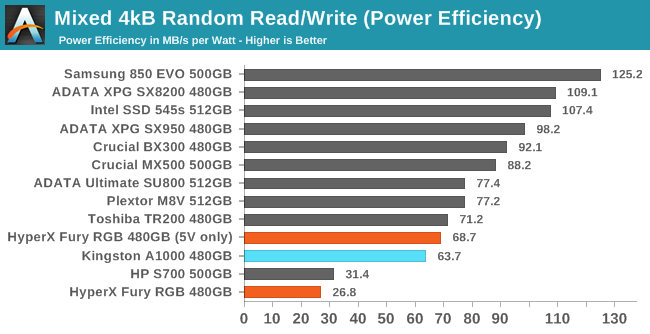 |
|||||||||
| Power Efficiency in MB/s/W | Average Power in W | ||||||||
When excluding the power used by the LEDs, the Fury RGB uses a bit less power on this test than most mainstream SATA SSDs. But the performance is low enough that the efficiency rating is still substantially lower than mainstream competition like the Crucial MX500.
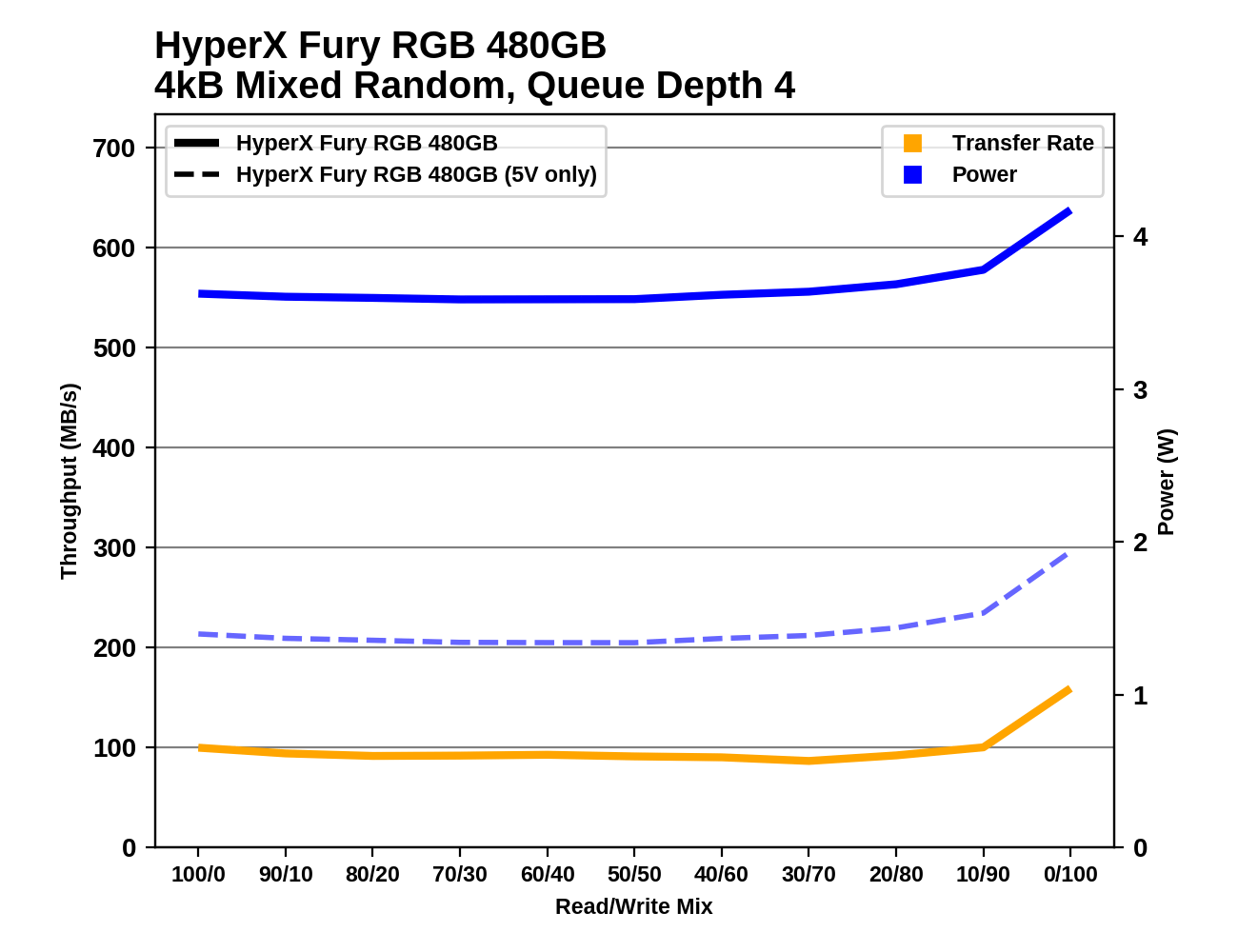 |
|||||||||
The performance and power consumption of the Fury RGB on the mixed random I/O test are both fairly steady throughout the test save for the typical jump at the end of the test when the workload shifts to pure random writes. Most mainstream drives deliver gradually increasing performance over the course of the test as the proportion of writes increases, and even some of the other BiCS3-based drives make significant gains during the last third of the test.
Mixed Sequential Performance
Our test of mixed sequential reads and writes differs from the mixed random I/O test by performing 128kB sequential accesses rather than 4kB accesses at random locations, and the sequential test is conducted at queue depth 1. The range of mixes tested is the same, and the timing and limits on data transfers are also the same as above.
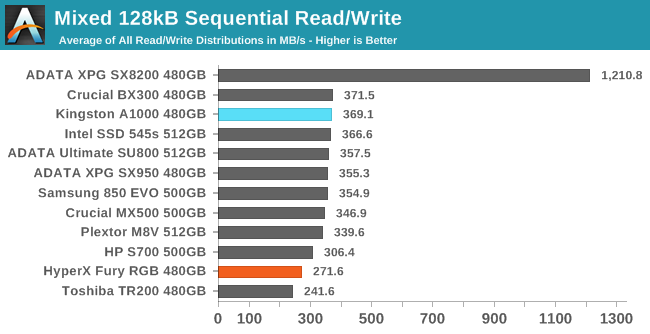
On the mixed sequential I/O test we again see the HyperX Fury RGB performing like a DRAMless SSD with at least 20% lower performance than most mainstream SATA SSDs.
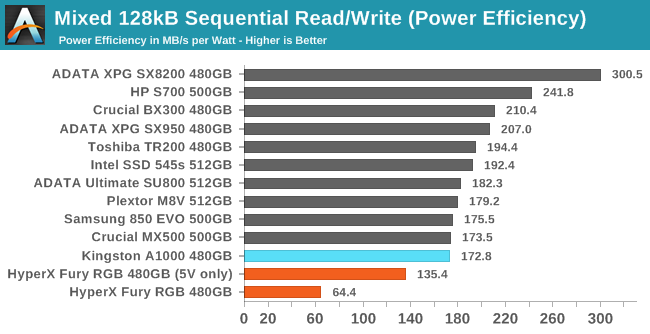 |
|||||||||
| Power Efficiency in MB/s/W | Average Power in W | ||||||||
The storage side of the Fury RGB consumes the normal amount of power for a mainstream SATA SSD on this test, so ends up with a clear last-place efficiency score. The DRAMless drives that perform similarly to the Fury RGB consume much less power and have above-average efficiency.
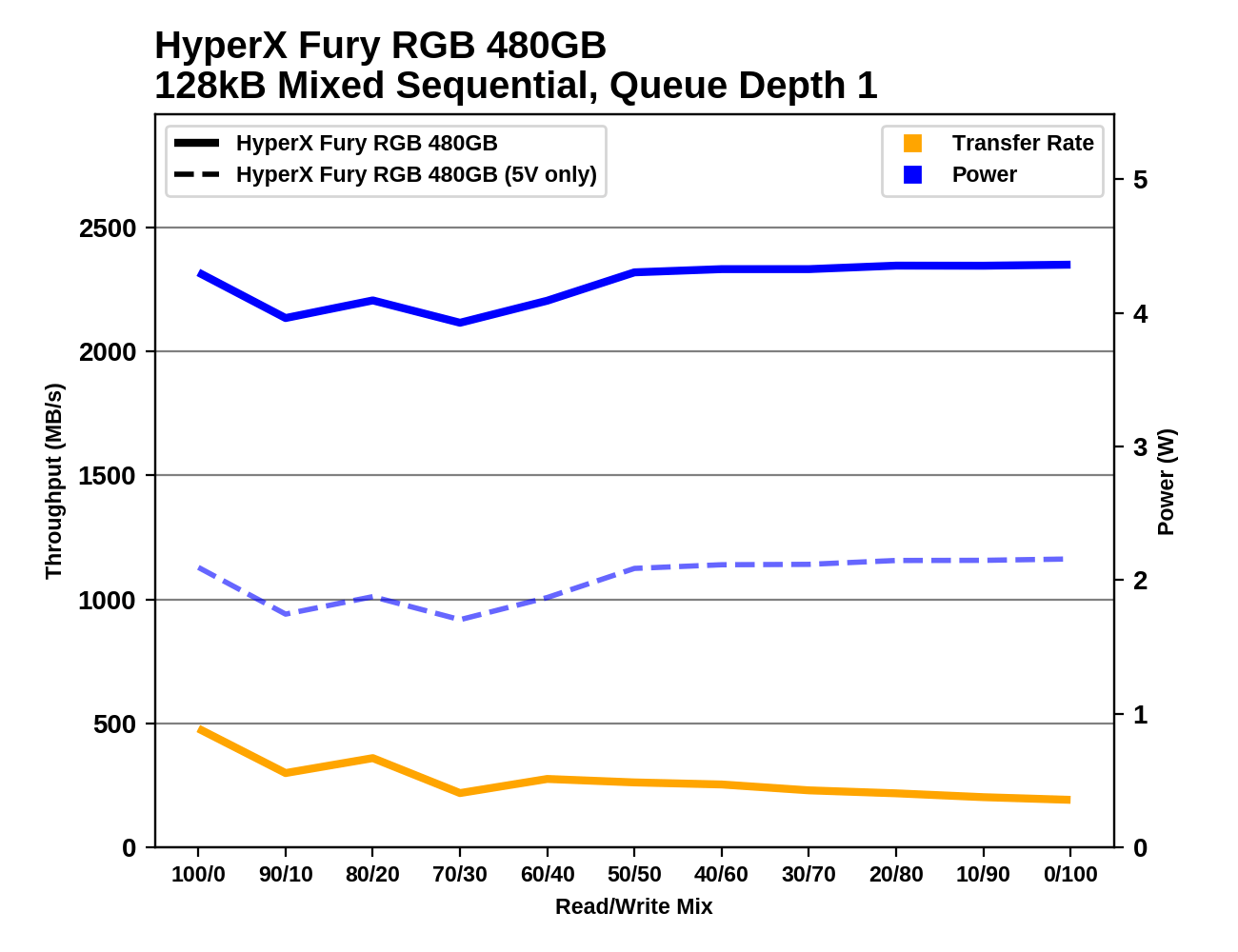 |
|||||||||
During the first third of the mixed sequential I/O test the performance of the HyperX Fury RGB is inconsistent. As the proportion of writes in the workload increases, the drive settles down into a gradual decline in performance that keeps it just above the Toshiba TR200.










45 Comments
View All Comments
PeachNCream - Monday, September 24, 2018 - link
Form over function. All show and no go. - Those are the first things that pop into my mind after seeing the bottom drawer performance and high power consumption. We now have reached the point where there's a component that burns more electrical energy feeding pointless LEDs than it does actually fulfilling its duties as a component in a computer. Here's to enthusiasts and gamers! Good going people. You've really made the world a better place by making LEDs on everything marketable.rrinker - Monday, September 24, 2018 - link
Most make me an old fogey, but I totally agree. I'm not sure why any gamer or enthusiast would even buy this thing, do the flashing lights actually make up for the reduced performance - considering it's supposedly 'performance' these people are after. Perhaps this may be the jump the shark moment for RGB on everything - it's now gone so far that is actually affects the performance of the peripheral the lights are supposed to be 'enhancing'.melgross - Monday, September 24, 2018 - link
No, lighting is very important to a segment of that market. Lit DRAM, feet, strings of LEDs and neon inside, and out. Replacing the cover with a clear plastic one(violating the FCC protocols), is very important to them.Stupid cases such as the ones from Alienware, and others, show what these in the gaming community want. Not all of them are like that, but a big enough percentage are, and it’s a VERY big market. They get over 100,000 people to some of the ComicCons around the country.
rrinker - Monday, September 24, 2018 - link
The difference being, this one actually reduces performance. At least with most anything else up til now, it was just added cost and some increased power consumption, but the LEDs on the RAM don;t make the actual chips hotter, or the LEDs controllers on the mobo don't make the VR modules or chipset run hotter and throttle. I could probably run a lot of LEDs and still use less power than my system was when it had a GTX480, which I replaced with a GTX970. But that's just power draw, even if my system wasn't half buried in a stand under my printer next to my desk, gaudy case lighting wouldn't cause my CPU or GPU to throttle. This thing - this is just all-around fail. I guess this does not apply to the serious performance nut - the ones who swear they can tell the difference between 1MHz differences in clock speeds to the CPU or RAM, because they probably wouldn't be running SATA SSDs anyway, but this is just beyond insane, reducing performance and increasing cost for the sake of a bunch of flashing lights. I have a bridge to sell the people that go for this, too. Oh wait, I better add lots of LED lights to it first.melgross - Monday, September 24, 2018 - link
RAM runs hot as it is. Adding LEDs doesn’t help. Does it damage performance? I don’t know.qlum - Tuesday, September 25, 2018 - link
DDR4 doesn't run that hot and adding leds on the edge of the memory sticks doesn't impact the temperature of the ram much. Heat from the top of the sticks is pretty easy to dissipate. Besides that this sdd uses way too much leds and blocks most of their light.dromoxen - Tuesday, September 25, 2018 - link
The telling point is that you can use this without the data storage functionality (and excess cables) getting in the way of its true purpose, which is to light the way to the Promised LandTitanX - Tuesday, September 25, 2018 - link
indeed..i want not a single light on my PC except for the HDD activity and power indicator. no glass..no view panels..just an inconspicuous black box.MrSpadge - Monday, September 24, 2018 - link
At least the naming is adequate: it makes you hyper furious while waiting for your data and wondering about your electricity bill!TitanX - Tuesday, September 25, 2018 - link
dude..its 2 watts...dont think that makes more than a nickel a year on the ole bill..